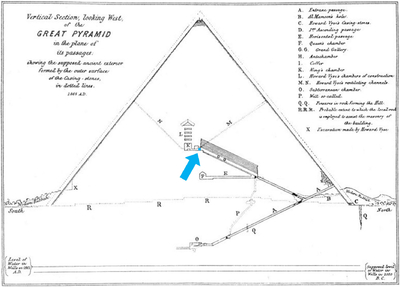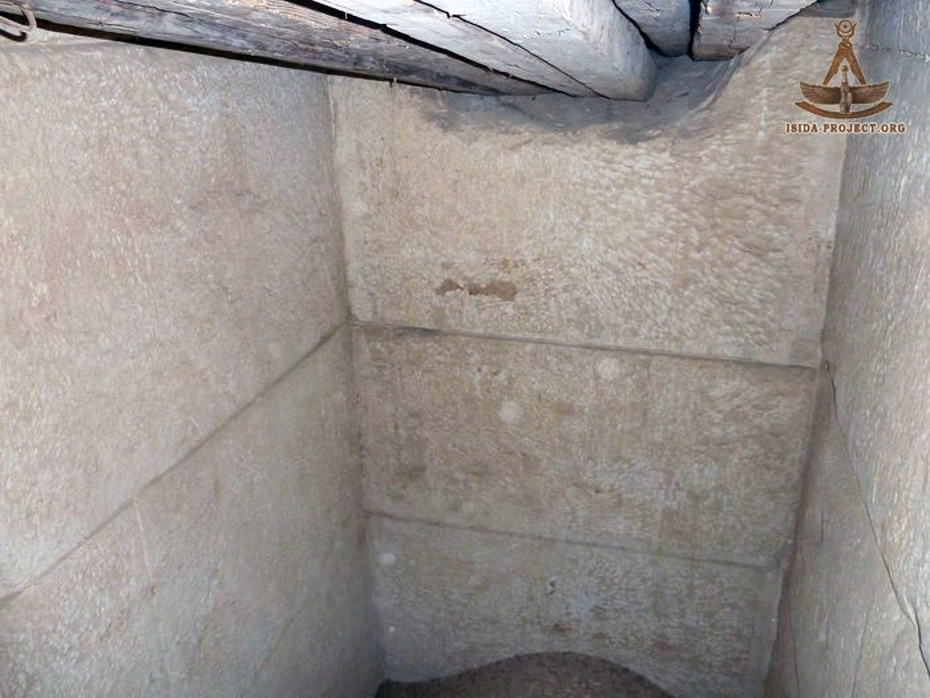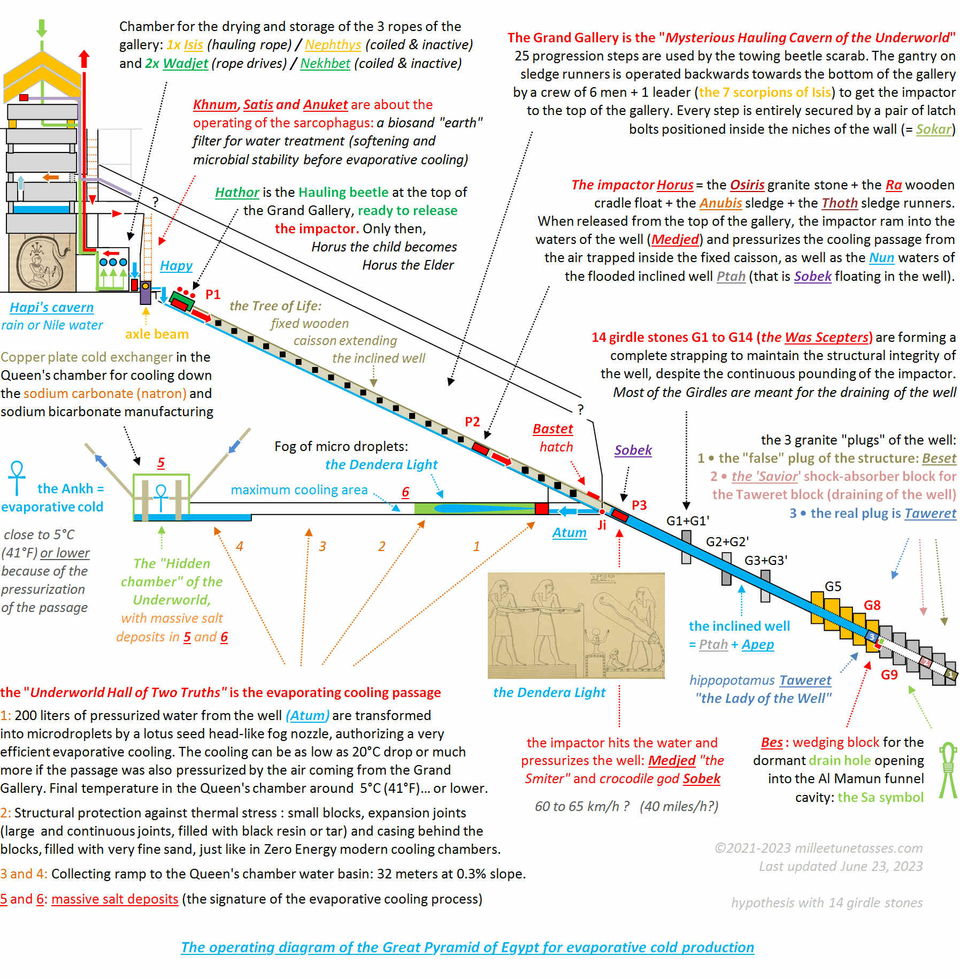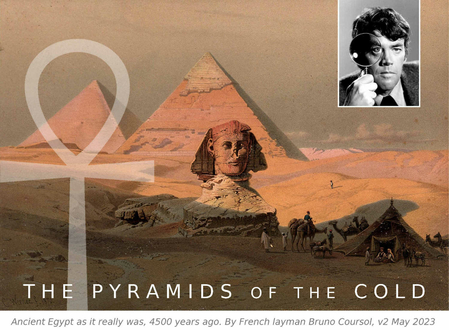- Retour accueil
- Vous êtes ici : Blog The Pyramids of the Cold v2 The Pyramids of the Cold Section 29 • The biosand filter sarcophagus of the Great Pyramid
The Pyramids of the Cold Section 29 • The biosand filter sarcophagus of the Great Pyramid
Publié par Bruno Coursol dans The Pyramids of the Cold v2 le 13/05/2023 à 18:50

The coffer of the Great Pyramid of Khufu: "Great Pyramid Passages" Volume 1, Plate CXXV page 250, by John and Morton Edgar in 1910: https://archive.org/details/GreatPyramidPassagesVol11910Edition/page/n259/mode/1up
Production of drinking water by biosand filtration: https://wiki.lowtechlab.org/wiki/Water_-_Biosand_Filter#
The Pyramids of the Cold v2 (May 2023) • Part E: the very large and roughly finished "sarcophagus" of the Great Pyramid
Section 29 • The biosand filter "Sarcophagus" of the Great Pyramid

In summary: the sarcophagus of the Great Pyramid of Giza, was a biosand filter for water softening, originally operated in the little room located between the antechamber and the entry to the Grand Gallery.
The water treatment by biosand filtration is producing drinking water, but it was performed to control scale, corrosion, and microbiological growth within the evaporative cooling process in the horizontal passage of the pyramid.
Despite the sarcophagus filtration and the softening of the water used to power up the Great Pyramid, salt encrustations in both the horizontal passage and the Queen's chamber were discovered by the first explorers of the pyramid. The salt deposits were up to one-half inch thick, before being removed in 1998 under the supervision of Zahi Hawass, as Director General of the Giza monuments.

29.01 The original location of the sarcophagus
The granite "sarcophagus" found in the King's chamber of the Great Pyramid of Giza, for many reasons couldn't have been designed for the mummy of pharaoh Khufu: there is absolutely no sign, decoration or hieroglyph nowhere on the object, nor there is anywhere in the King's chamber or in the entire pyramid, if we don't consider the quarry marks found in the "relieving " chambers.
Plus, the granite box has been meticulously hammered down, on its entire top surface as well as along the slot on one of its corners. That work alone, would have take maybe 30 minutes or a full hour to realize for one person; and for what other reason than to hide the specific design that was implemented onto these parts, and maybe because the box was simply not operated in the King's chamber, where it had been found and it had to be taken out from where it had been neatly installed originally, and taken out of there with force.

The sarcophagus of the Great Pyramid of Giza and the location where it had been operated for water treatment as a biosand filter, in between the antechamber and the opening to the Grand Gallery.

Original drawing by Franck Monnier: https://en.wikipedia.org/wiki/Great_Pyramid_of_Giza#/media/File:Kheops-chambre-roi.jpg
29.02 The traces of the original location of the sarcophagus
On the above drawing from Franck Monnier, we can very easily see where the sarcophagus was set during the operation period of the Great Pyramid of Giza.
Please note the intensive digging that had been made around the sarcophagus water supply shaft, either because something technologically important needed to be wrecked by ancient Egyptian themselves (most probably the portcullis apparatus), or because someone in modern times, guessed that something important was happening here and tried to find out more.
Please also note that the 4 air ducts would have passed right through what is described today as part of a forced tunnel, presumably digged by Vyse.

The strange trajectory of the northern King's chamber shaft of the Great Pyramid of Giza.
Original images thanks to the Bibliothèque nationale de France. "Histoire de l'art égyptien d'après les monuments, depuis les temps les plus reculés jusqu'à la domination romaine" 1858-1879, by Émile Prisse d'Avennes (1807-1879). © Bibliothèque nationale de France, département Réserve des livres rares: http://passerelles.bnf.fr/grand/pas_2457.htm
29.03 The strange trajectory of the northern King's chamber shaft
The first thing to note is that if the northern shaft as a very particular trajectory, it is because it was designed to come close to the sarcophagus. In this area, everything was built around the sarcophagus: the red dotted line indicates what would be the exact duplicate of the southern King's chamber shaft, obviously something was supposed to be right on the trajectory.
The second part is a little tricky to understand, because the above drawing is in 2 dimensions only. What one need to mentally add to this draw is the height data : the shaft is going up from the King's chamber to the exterior of the pyramid.

29.04 The well of the King's chamber and the biofilm of the biosand filtration
It is possible that the well inside the King's chamber, could validate the idea that the sarcophagus was a biosand filter, with a living biofilm on its surface, because it would have been a perfect water reserve to secure the biofilm even when the chamber was empty.
In biosand filters, it is crucial that the biolayer stays under water all the time. If the upper layers of the filter get dry, the biolayer dyes and the filter will need 30 days to get a functional biolayer back, starting when water is coming back into these upper layers.
We know that the water that powered the Great Pyramid, was coming from the annual flood of the Nile, and there was most probably very irregular water levels, regularly or in some particular periods of time.
The well would have saved the biolayer when water supply was failing.

"Modeling Improved Performance of Reduced-Height Biosand Water Filter Designs" by James A. Phillips and Samuel J. Smidt, and published on MDPI: https://www.mdpi.com/2073-4441/12/5/1337
29.05 The extreme diversity of biosand filter designs
The images that are illustrating this part of the study are about biosand filters, designed to provide clear drinkable water in people's homes.
These biosand filters are perfectly adapted to fit in people's homes, but they can be find in many shapes and sizes, in particular there are a lot of high capacity sand filters with the exact same shape as the sarcophagus of the Great Pyramid, as shown below.

On the above photographs, the curious L shape of the portcullis is only due to formers egyptologists that needed to get pass through the portcullis, so they simply cut it out.
The sand filter of Sneferu's Bent Pyramid, in the east-west passageway that has its entrance on the west face of the pyramid (this is at the first portcullis, at the western side of the passage). Images from guardians.net: https://guardians.net/egypt/cyberjourney/dahshur/bentpyramid/bent_pyramid_interior.htm
29.06 The sand filter of the Bent Pyramid
The reason I'm confident that the sarcophagus was for sand filtration, is that this equipment was already in use in the Bent Pyramid of King Sneferu. Obviously, it is not something that egyptology is talking about, and in the academic studies about this pyramid, it looks like it was preferred to be completely forgotten.
But here it is: a perfect sand filter, with (most probably) its original sand, the water supply portcullis that is neatly adapted to the filter and the collecting basin as well.

The shape of the portcullis perfectly designed to control the water supply of the sand filter.
29.07 Why was the Bent Pyramid sand filter for ?
Why did the Bent Pyramid has been built for, looks much more difficult to comprehend.
I would say it served the purpose of being a last series of trials before the Great Pyramid was built.
For example the lower section could have served for the development of a more efficient limestone kiln with the chimney that would have been air intake, and the sand filter could have been the "prototype" of the sand filter in the Great Pyramid.
I think that the fact this pyramid has two separate entrances on two different faces, and that starting at a 52° angle it suddenly changes to a more gradual angle of 43°, is because they wanted to try many things on this pyramid.
29.08 The umpteenth changed of plans and the foolish idiots
Once again, the idea that Sneferu's engineers changed their minds at the very last minute, because they realized that at 52° angle, the pyramid would have been too high, is outrageous.
Everyone on Earth is fascinated by the extraordinary ancient Egyptian artifacts beauty, that could only come from a very advanced civilization, and in the same time they accept the idea that they were also foolish idiots.
We should be ashamed of ourselves… this is my personal opinion.

The so-called "shaft" here is nothing but the filtered water collecting tank of the sand filter (biosand filter?). Images of the Bent Pyramid of Sneferu, thanks to the ISIDA Project, International Society for Investigating and Discovering Artifacts: https://isida-project.ucoz.com/egypt_2012/dashur_bnt_corridor.htm

Functioning of a Biosand filter for drinking and softening water production: https://www.cawst.org/services/expertise/biosand-filter/more-information
29.09 What is a Biosand Filter ?
A biosand filter (BSF) is an adaptation of the traditional slow sand filter, which has been used for community drinking water treatment for 200 years. The biosand filter is smaller (about 1 m tall, 0.3 m wide on each side) and adapted so that it does not flow continuously, making it suitable for use in people’s homes. The filter container can be made of concrete or plastic. It is filled with layers of specially selected and prepared sand and gravel. The sand removes pathogens and suspended solids from contaminated drinking water. A biological community of bacteria and other micro-organisms grows in the top 2 cm of sand. This is called the biolayer. The micro-organisms in the biolayer eat many of the pathogens in the water, improving the water treatment.
Pathogens: micro-organisms in water that make us sick
Suspended Solids: dirt and other small pieces in the water (may also be called “turbidity”)
Source: https://www.cawst.org/services/expertise/biosand-filter/more-information

Photographs from: https://wiki.lowtechlab.org/wiki/Water_-_Biosand_Filter#
29.10 The link between heat (or cold) transfer efficiency and the water treatment in cooling systems
"Effective water treatment works to control scale, corrosion, and microbiological growth within an evaporative cooling system. It also helps to ensure heat transfer efficiency and extend the service life of the equipment."
"When an evaporative cooling system rejects heat to the atmosphere, only pure water is evaporated. As this occurs, the dissolved ions—naturally occurring in the makeup water source—are left behind. Without proper water treatment, the dissolved ion concentration increases as evaporation continues and, at some point, will reach saturation of the ions, which can lead to scale. The most common form of scale is calcium carbonate. Preventing scale via water treatment impacts the efficiency of heat transfer, thereby reducing energy consumption of the entire system."
"Microbiological growth in evaporative systems can lead to accelerated corrosion rates, heat transfer deficiencies due to biofilm, as well as human health related concerns. There are a variety of reasons why one system may experience higher biological activity than another. Tower location, nearby construction or farming operations, the makeup water source, and more can all lead to an increased level of bacteria in the water."
Excerpt from the website of EVAPCO, Westminster, Maryland, United States: https://www.evapco.com/faq/answer/water-treatment-evaporative-cooling-system

The sarcophagus of the Great Pyramid of Giza, was a biosand filter originally operated in the little room located between the antechamber and the entry to the Grand Gallery. The water treatment by biosand filtration was to control scale, corrosion, and microbiological growth within the evaporative cooling process.
"Ram Pokherai drinks clean water from his family's biosand filter. Clean water helps children stay healthy, which means they are less likely to need time away from school, so their education improves. Providing clean water has important knock-on effects." Courtesy of Editorial, Humanitarian & Travel Photographer Gavin Gough: https://www.gavingough.com/clean-water-in-rural-nepal
Images from this assignment are being used to raise awareness of the important work that Centre for Affordable Water and Sanitation Technology, CAWST is doing, providing the resources and education required for reliable clean water supplies in rural areas: https://www.cawst.org/
29.11 The sarcophagus was a biosand filter for water softening for the evaporative cooling process
I first thought that the sarcophagus found in the King's chamber was a biosand filter for production of drinking water for the crewmembers of the hauling Beetle, but I have to admit it was a little… romantic, I would say.
Nowadays, evaporative cooling is a extraordinary process, but like every process it has some disadvantages, and the most problematic is surely limescale : salt encrustation.
4500 years ago, ancient Egyptians had to deal with that same problem, and they did exactly what we do today: they softened the water coming from the King's chamber, and they used biosand filtration for that matter.
The most amazing thing is that everybody knows the sand filter that was used inside the Great Pyramid to soften the water: it is the so-called granite Sarcophagus of the King's chamber.

The coffer of the Great Pyramid of Khufu: "Great Pyramid Passages" Volume 1, Plate CXXV page 250, by John and Morton Edgar in 1910: https://archive.org/details/GreatPyramidPassagesVol11910Edition/page/n259/mode/1up
Production of drinking water by biosand filtration: https://wiki.lowtechlab.org/wiki/Water_-_Biosand_Filter#
29.12 The sarcophagus of the Great Pyramid could have produced 201.96 liters of filtered water every 15 minutes
I've suggested the hypothesis that every 15 minutes or so, it was about 200 liters of water that would have been ejected from the inclined well towards the evaporative cooling passage. It just sounded right, but I didn't check one thing: was the biosand filter sarcophagus able to supply that amount of water?
I'm not an engineer, so this whole "practical" thing about numbers is clearly not my cup of tea, even if it was both crucial for the operation of the Great Pyramid and very easy basic science:
With an internal surface area of 1.98 m x 0.68 m = 1.3464 m², and a theoretical flow rate of 600 liters/hour/square meter (according to ACF data, below), the biosand filter of the Great Pyramid of Giza would have been able to supply 807.84 liters of filtered water every hour.
That is 201.96 liters of softened and microbial stable water every 15 minutes.
"The internal dimensions [of Khufu's Sarcophagus] are roughly 198 cm (6.50 ft) by 68 cm (2.23 feet), the external 228 cm (7.48 ft) by 98 cm (3.22 ft), with a height of 105 cm (3.44 ft)." https://en.wikipedia.org/wiki/Great_Pyramid_of_Giza
"The biosand filter has been designed to allow for a filter loading rate (flow rate per square meter of filter area) which has proven to be effective in laboratory and field tests. This filter loading rate has been determined to be not more than 600 liters/hour/square meter." From ACF: https://www.actionagainsthunger.org/sites/default/files/publications/Biosand_and_ceramic_filters_training_manual_02.2010.pdf
"ACF is a Non-Governmental Organisation (NGO). It can also be called Action Contre la Faim (ACF) which is a French phrase meaning Action Against Hunger. ACF began in France in 1979 and currently, it operates in 40 countries worldwide."

"Khufu's sarcophagus, broken by robbers, in the sepulchre-chamber of the Great Pyramid, Egypt", Library of Congress Control Number 97502567: https://tile.loc.gov/storage-services/service/pnp/stereo/1s20000/1s21000/1s21300/1s21351v.jpg

Diagram of the operating Great Pyramid of Egypt for evaporative cold production (hypothetically for chemical manufacturing cooling of pure sodium carbonate "natron", the salt used for the mummification of pharaohs). When in operation, the elevation of the Great Pyramid was not finished, and it is only after the shutdown procedure and the draining of the inclined well, that the 3 granite plugs were finally close to one another.

The Pyramids of the Cold version 2 (May 2023 - March 2024)
Summary of the study and Table of Contents
Part A: The evaporative cooling process
Section 1 • The horizontal evaporative cooling passage layout
Section 2 • The Dendera Light and the creation of the fog of microdroplets by the fog nozzle
Section 3 • The water cycle glorifying metaphors: Geb, Shu, Nut, Tefnut
Section 4 • The theorization of the evaporative cooling process by Akhenaten and Nefertiti
Section 5 • The theorization of the evaporative cooling process in the Weighing of the Heart
Part B • The inclined well of the Great Pyramid of Giza
Section 6 • The inclined well layout and the girdle stones
Section 7 • The Taweret "Lady of the Well" temporary sealing granite plug of the well
Section 8 • The Bes temporary wedging block immobilizing Taweret
Section 9 • The draining of the well
Section 10 • The Great Serpent Apep and the snake water metaphors
Section 11 • The Was scepter and the control over "snakes"
Section 12 • The beating Heart of the Great Pyramid
Part C • The composite impactor of the Great Pyramid (Horus, Ra, Osiris, Medjed, Sobek...)
Section 13 • The wooden and stone composite design of the impactor: Ra and Osiris
Section 14 • The endlessly immersed Osiris stone and the seed metaphor
Section 15 • The Anubis sledge and the bobsled mask
Section 16 • The sledge runners of the impactor: Thoth
Section 17 • Medjed: the smiter nobody can ever see
Section 18 • The Apis bull and the ramming impactor's metaphors
Section 19 • The crocodile god Sobek impactor (more or less) floating in the waters of the well
Section 20 • The Obelisk and the Benben stone rising from water
Part D • The Grand Gallery's of the Great Pyramid of Giza
Section 21 • The Sacred "sloping paths" of the "oval-shaped cavern of the act of Hauling"
Section 22 • The central wooden caisson of the Gallery: Sekhmet and the Triad of Memphis
Section 23 • The hauling ropes of the Grand Gallery: Isis, Nephthys, Hatmehit, Wadjet and Nekhbet
Section 24 • The hauling Beetle and the Seven Scorpions of Isis
Section 25 • The Great Cow goddess Hathor and the operating cycle of the hauling Beetle
Section 26 • The 10 operating phases of the Grand Gallery
Section 27 • The guide to the Afterlife for the smart traveler and the canopic jars
Section 28 • The scarab amulet glorifications of the hauling Beetle
Part E • The very large and roughly finished sarcophagus of the Great Pyramid
Section 29 • The biosand filter sarcophagus of the Great Pyramid
Section 30 • The Elephantine Triad deification of the biosand filter of the Great Pyramid
Section 31 • The Great Pyramid's operating flat roof and the water supply issue
Part F • Chemical manufacturing and industrial cooling before the Great Pyramid
Section 32 • The Serdab and the "Refreshment of the Gods" Step Pyramid of Djoser
Section 33 • Sneferu's Red Pyramid and the accumulated ammonia
Section 34 • The Disc of Sabu and the Solvay process for pure natron manufacturing
Part G • The tremendous impact of the Great Pyramid on the whole ancient world
Section 35 • The hidden secrets of the Hermetica Emerald Tablet (around 1600 C.E.)
Section 36 • Thor and the magical Hammer in the Great Hall of Bilskirnir
Section 37 • The Churning of the waters of the Ocean of Milk (Hindu mythology)
Section 38 • The Tibetan prayer wheels and the Grand Gallery's operation
Section 39 and Conclusion • The cooling water of spitting Kebechet
Part H • Epilogue
Section 40 • The smiting Ark of the Covenant and the Ten Commandments
Section 41 • The 293 kilograms windlass Staff of Moses and Aaron... and the First Plague of Egypt: water turning into blood
Section 42 • Ezekiel's Four Egyptian pulley "Wheels within the Wheels" and the four angel ropes
Section 43 • David, Saul, two giant Goliaths, five little stones, an aeolian harp... and a weaver's beam
Section 44 • The holy water fonts and the biosand filter
Part I • The magicians of the Great Pyramid of Giza
Section 45 • The Legend of Khufu and the "magician" polymath Imhotep
Section 46 • The two magical eyes of Isis and the brilliant but painful flame of her twin sister's braids
Poster un commentaire
